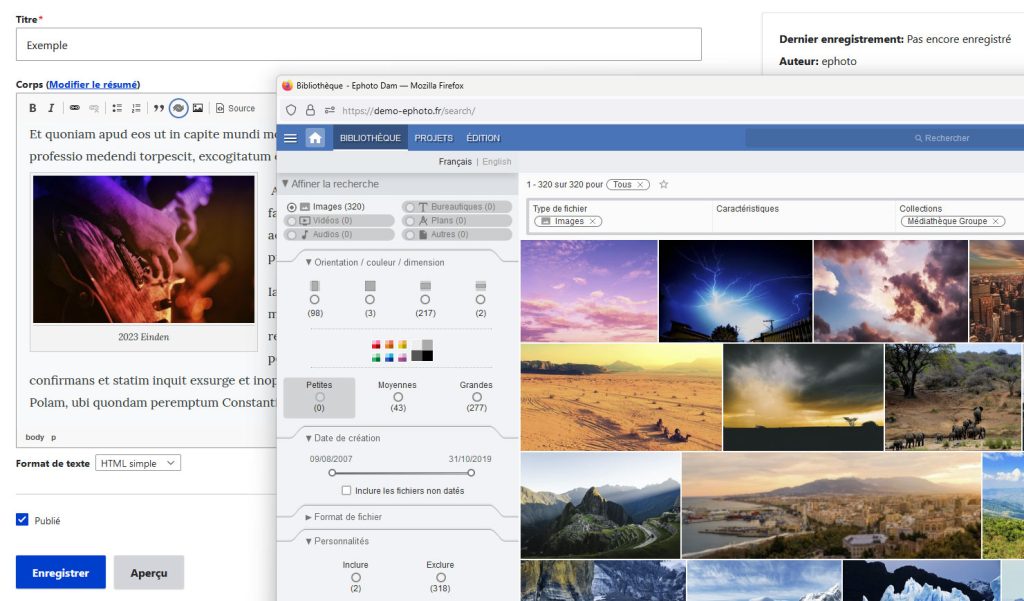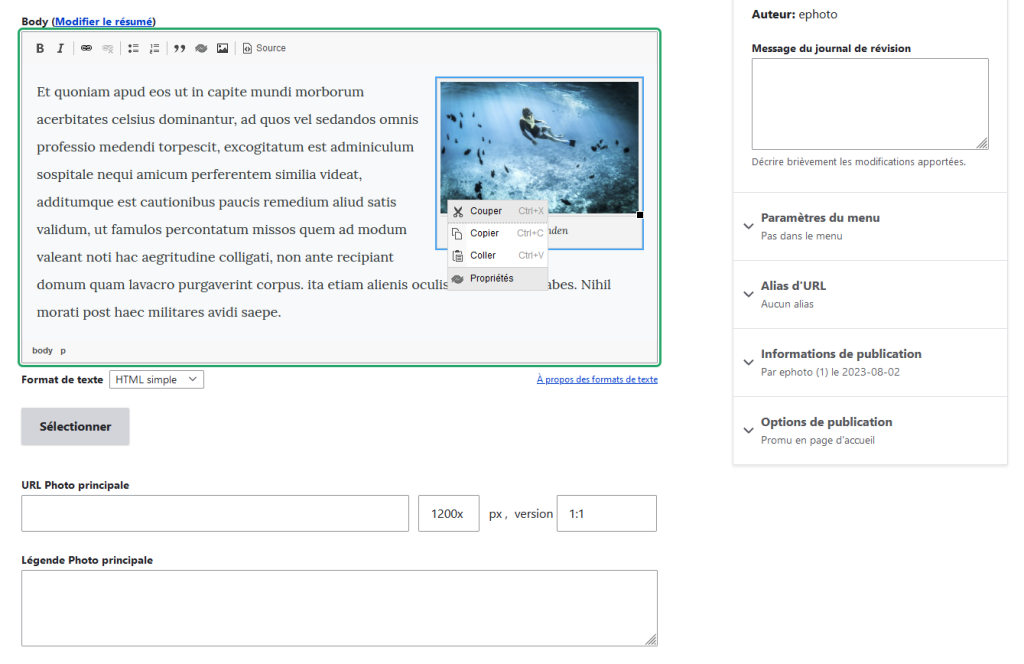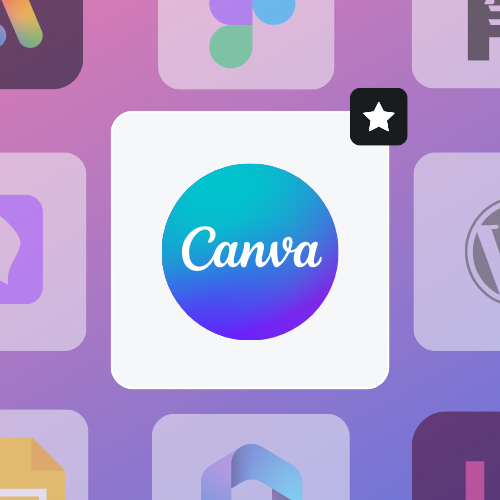Ephoto Dam connected to your Drupal 11 CMS
For several years now, Ephoto Dam has had its own Drupal extension to facilitate the integration of its customers’ media into websites created with the CMS. As the solution is dedicated to media management, it is its natural role to ensure that images, documents and videos are made available to third-party tools, along with any associated metadata if required.
Screenshot of the Drupal 10 interface showing a new feature
Media are integrated into web pages using broadcast urls, so there’s no need to duplicate media on web platforms. Ephoto Dam remains the sole source of media and automatically manages optimisation and caching for rapid distribution.
In addition, the workflow followed by a DAM user is to describe their media and manage rights before distributing them. Allowing access to Ephoto Dam directly from Drupal streamlines the distribution process while controlling rights (because they are managed by the DAM)

CMS features
The Drupal plugin includes two modules:
- ‘Ephoto Dam Embed’, which enables media to be integrated quickly and easily into free page layouts. In just two clicks, the user accesses the DAM interface and selects the media to be embedded,
- ‘Ephoto Dam Field’ facilitates and automates the integration of media into standardised pages (product pages, catalogue sheets, etc.). This module is particularly popular with developers, offering a number of advanced options. The module enables them to prepare their templates with the guarantee that the images and videos integrated into the pages will be the right size and format.
The extension lets you specify the optimisation of the images to be displayed: resolution, ratio, format and compression. The different versions to be displayed are then automatically generated and cached. As the DAM remains at the source, all you have to do is import a new version of the media and all the variations are automatically updated on the pages.
The Ephoto Dam platform also provides webhooks so that developers can be automatically informed of any changes to media (modification of the associated indexing, expiry of rights, new version, etc.), enabling them to develop immediate updates for their content.

Thanks to the various implementations of the plugin carried out with our customers, we have improved the plugin over the years, taking into account the many needs that their expertise has helped us to identify.
The new version of the Drupal plugin
As part of our drive for continuous improvement, we’re always listening to our customers and the web agencies who work for them. As a result, we now have the most advanced Drupal plugin on the DAM market.
Since version 10 of Drupal, the plugin has been validated by the Drupal community. The aim is to comply as closely as possible with the best practices of the CMS, so that it can be easily used by any Drupal developer. This is a guarantee of the plugin’s quality, as well as its ease of integration into an existing Drupal system.
Between version 9 and 10, the ‘Ephoto Dam Embed’ module has been completely overhauled to take media editing and integration even further.
This comprehensive Drupal plugin covers our customers’ needs from the simplest to the most advanced:
- management of image sizes, formats (such as WEBP) and compression,
- versioning management,
- video streaming management,
- use of Ephoto Dam’s internal application cache,
One of the advantages, as mentioned above, is the optimisation of your storage and bandwidth. The media are already stored by the DAM and there is no need to store them elsewhere, this is a basic principle. Ephoto Dam feeds the various platforms with media that the application will keep in cache and these will be renewed according to a predetermined timing (TTL). If you add support for the WEBP format, you’ll also see a marked improvement in the performance of your site. All this adds up to an optimised distribution ecosystem that is often more in line with a demanding CSR policy.
Our advice on how to get the plugin to work properly
Many of our customers now use the Drupal plugin to feed images to their corporate sites. Every day, several hundred thousand images are delivered by Ephoto Dam and displayed on these sites, sometimes accompanied by selected metadata.
If you are interested in integrating the Ephoto Dam plugin for Drupal, here are a few tips:
To install the plugin, first download it from the official Drupal.org Store,
When you install it, you will get the two modules: Ephoto Dam Embed and Ephoto Dam Field,
Remember to specify the URL of the Ephoto Dam server in the configuration,
If you want to use several different ratios or framings for the same image, prepare them beforehand in your Ephoto Dam,
configure the dimensions of the images you want according to your site’s specifications (performance, display quality, etc.) in the Content type / Field / ‘Ephoto Dam’ section.
The Ephoto Dam team will be happy to help you set up the Ephoto Dam plugin for Drupal.
You can find all our plugins for the Adobe or Office suite in the Ephoto Dam Store, as well as the plugin for WordPress if you use this CMS instead!


